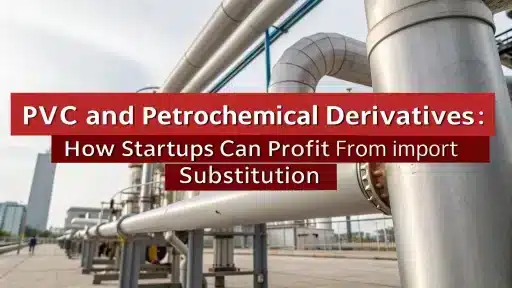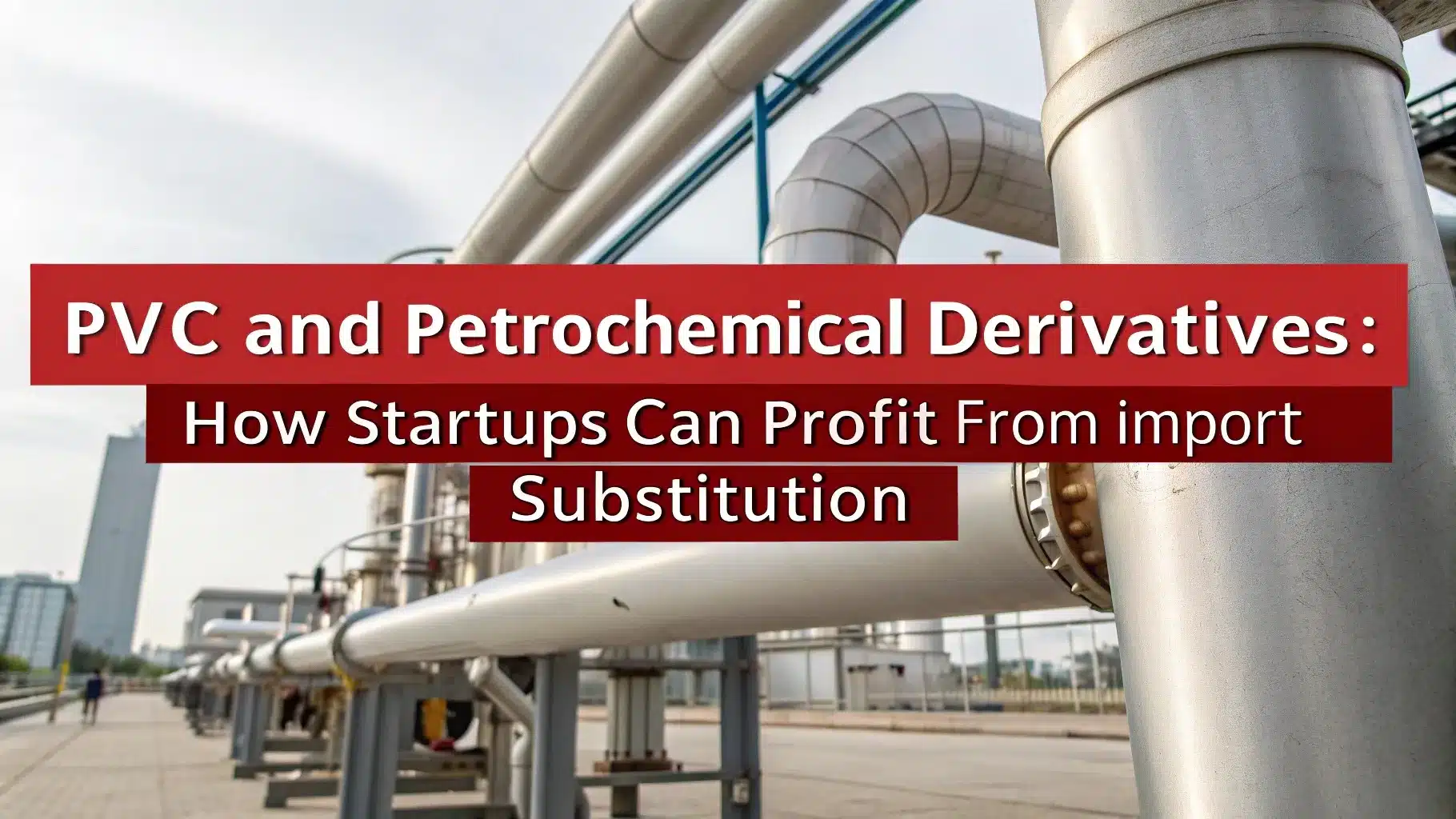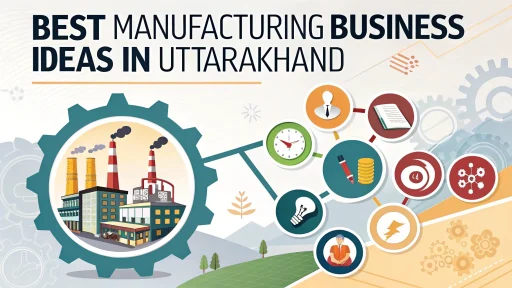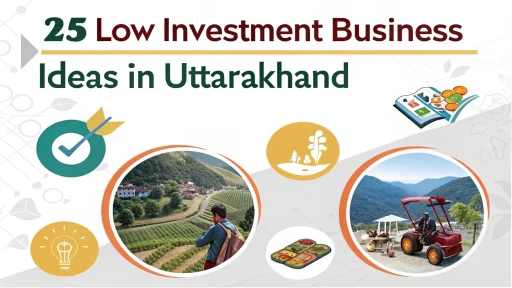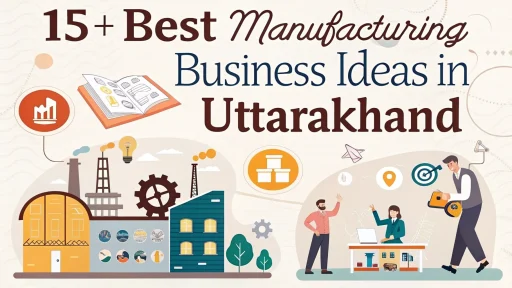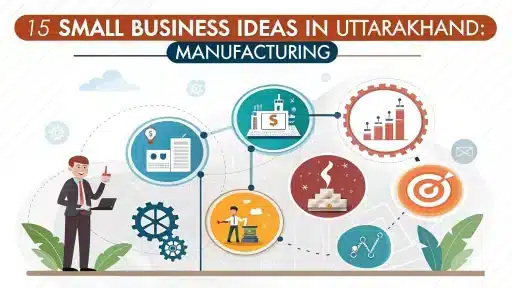A New Wave of Opportunity in Petrochemical Manufacturing
India’s industrial growth trajectory is entering a critical phase, where self-reliance is not just an option of choice but a deep economic requirement. One of the sectors transforming is the petrochemical industry, which now also serves as an abundant area of concern and growth potential. PVC and its derivatives are at the core of this industry, a product segment that India mostly imports but has a growing demand, domestic end-user base, and the infrastructure to increase raw materials supply.
For entrepreneurs and MSMEs keen on stepping into manufacturing, the window of opportunity in Petrochemical Derivatives India is open wide. There is significant dependency on imports for the PVC compounds and resins, which chlorinated solvents, plasticizers, and synthetic rubbers downstream derivatives fill, and can strategically be served through import substitution manufacturing.
In this article, we explore market scope, petrochemical derivatives, and manufacturing opportunities in PVC, focusing on how startups can create business models that fuel India’s ambition for industrial self-reliance.
Related: Government Initiatives to Boost the Petrochemical Sector
Petrochemical Derivatives and PVC: Essentials of Modern Industry
Petrochemical derivatives are chemical compounds derived from basic petrochemicals like ethylene, propylene, butadiene, and benzene. PVC is a versatile and widely employed polymer across the world, further refined into numerous derivative products for various industries.
Common PVC Derivatives Include:
- PVC compounds for pipes, cables, footwear, and packaging
- CPVC (Chlorinated Polyvinyl Chloride) for hot water plumbing
- Plasticizers like DOP (Di-Octyl Phthalate) for increasing flexibility
- PVC resins used in rigid and flexible packaging
- Synthetic rubbers and adhesives derived from vinyl chemistry
- Chlorinated solvents, and caustic soda used in textiles, paper, and pharmaceutical industries
These sectors are essential for construction, automotive, electrical, textiles, healthcare, and packaging. India, however, faces a challenge because a significant portion of these petrochemical products still need to be imported. This gap exists due to a lack of localized capacity, technical expertise, and production scale.
As a result, there is a valuable opportunity for innovative startups to capitalize on niche manufacturing and market clusters and the Make in India campaign.
The Benefits of Import Substitution: The Importance of PVC and Petrochemical Derivatives
The need for imported petrochemical intermediates has put India at risks concerning intermediate pricing and material availability. Items such as PVC resin, CPVC, and DOP face constant shipping delays, price fluctuations, and forex volatility. The recent global supply chain disruptions highlighted the importance of these materials in supporting India’s domestic industries.
The Atmanirbhar Bharat Vision and the recently introduced PLI schemes address these pain points. The Indian Government labeled PVC and its derivatives to be high-priority sectors for localization due to their widespread usage, impressive upstream linkages, job creation potential, and impact on localization.
Investors and entrepreneurs focusing on manufacturing petrochemical derivatives are not just capitalizing on established markets and building new businesses. They are pioneering replacements for foreign dependence with domestic innovation along with scalable models. There is strong existing market support for such transitions.
Demand Spirited: Growth in Downstream Lead Industries
India’s rapid expansion in construction and infrastructural development are drivers of economic growth, leading to increased consumption of PVC conduits, pipes, cables, and even profiles. Alongside this, the packaging sector’s surge, particularly in pharmaceuticals, food, and FMCG, has triggered tremendous demand for flexible PVC films and plasticized products.
Demand from the following sectors is also noteworthy:
- Automotive and EV sectors needing flexible electrical wire insulations and seals
- Healthcare and diagnostics segments using PVC for intravenous bags, tubing, and blister pack for packaging
- Textile and leather industries that use synthetic resins and coating compounds
- Chemical and process industries that use chlorinated solvents and caustic soda
These all are increasingly sourcing locally and reducing dependency which fulfills the niche need for B2B manufacturers capable of providing consistent quality tailored products.
Manufacturing Overview: How PVC and Its Derivatives Are Produced
Vinyl chain chemistry begins with the petrochemical derivative process, and it starts with the polymerization of ethylene and chlorine to create vinyl chloride monomer (VCM). Further polymerization yields PVC resin, which serves as a base material for a multitude of downstream products.
General Manufacturing Flow:
VCM Polymerization to PVC Resin
For instance, the monomer vinyl chloride (VCM) can be converted into powdered PVC resin via its polymerization through suspension and emulsion methods.The powder is then classified into distinct grades according to thermal characteristics and molecular weight.
Compounding and Additive Mixing
Additionally, manufacturers add colorants, lubricants, fillers, stabilizers, and plasticizers to modify the physical attributes of the resin. In the case of CPVC, a chlorination post-treatment enhances its temperature resistance.
Extrusion, Moulding, or Film Casting
Compounded materials are converted to polymetric resins or cables via extrusion, as well as films and sheets through calendaring. Injection moulding produces fittings and other components crucial to electronics.
Plasticizer Production (DOP/DBP)
Di-Octyl Phthalate (DOP) is produced through the reaction of intermediates, such as phthalic anhydride, with alcohol in a reactor. DOP is an important component for flexible PVC compounds due to its high plasticizing effect.
Solvent and Chlorinated Derivatives
Co-streams along with byproducts are processes further to create caustic soda and solvent ethylene dichloride and bleaching agents for application in other sectors.
Each route in manufacturing a certain product may differ in some aspects, but the basic skeletal structure of the raw materials used—ethylene, chlorine, and various additives—remain largely integrated. Mid-stream and downstream compounding are the best to start for companies looking to have lower capital investments since they are easier to modify and less expensive.
Related: Grow Your Cable Business with In-House PVC Compounding: Low Investment, High ROI
Technology Quality with Challenges
However, the technological complexity involved in manufacturing consistent-quality PVC derivatives presents a significant challenge for new businesses entering the industry.The morphology, thermal behavior, and mechanical strength of polymers differs greatly depending on the proportions of additives, temperature controls, and overall process conditions.
This makes the three vital areas of: process control, formulation R&D, and quality assurance. The small and medium sized enterprises in India have adopted automated compounding lines, closed-loop screw extruders with real-time viscosity control, and precision makeup pumps to meet export-grade standards.
Collaboration with supplier of extruders, testing labs, and chemical consultants are essential. Businesses focused on the R&D and quality of their products are now selling PVC flooring, automotive wire covering, and medical-grade films in emerging markets.
How Startups Can Enter the Market: Models and Strategies
Depending on the goals, location, and access to raw materials, the PVC and petrochemical derivatives industry provides various entry options for startups. Barriers to entry are more manageable if one avoids cracker units and centers on:
- Compounding plants for PVC in cable, pipe, and packaging industries
- Manufacturing plasticizers for flexible films and synthetic leather industries
- CPVC and solvent processing plants for high-value export productive and semi-finished goods
- Custom-grade formulation units for medical-grade and food-grade PVC films
- Specialty additives for stabilizers, UV modifiers, or fire-retardant compounds
Numerous Indian industrial clusters provide needed, streamlined infrastructure, logistical support, and chemical ecosystems which are perfect for plug-and-play startup biochemistry facilities.
Why This Sector Is Startup-Friendly
India already has an expanding refining and ethylene production infrastructure. This ensures long-term feedstock security. Low-cost logistics for regional B2B clusters like construction zones, pharma hubs, and auto parks boost refining and ethylene profitability.
Petrochemical startups benefit from lower GST on inputs, R&D funding, and export promotion schemes. Other players aiming at diversifying from China also want to buy specialty PVCs from India.
How NPCS Can Help You Get Started
Setting up a unit requires process engineering and marketing—making NPCS an ideal partner.
NPCS Offers:
- Customized Comprehensive Market Survey cum Techno Economic Feasibility Reports for each derivative product or segment.
- In-depth information on processes of manufacturing, sourcing of raw materials, designing the plant including its utilities, and technology routes.
- Concrete advice for assessing new projects to determine their commercial viability before making any financial commitments.
With decades of experience in chemicals and manufacturing, NPCS helps entrepreneurs make data-driven decisions and build successful ventures.
For more information check our Project Reports
Conclusion: The Petrochemical Opportunity is Real, and Now
There is a vast opportunity for entrepreneurs considering the PVC and petrochemical derivatives market due to the dependency on imports in India. There is an evident lucrative opportunity for import substitution as the growth of end-user industries coupled with rising demand is incentivized at multiple policy levels.
Incorporating precision manufacturing, agile supply chains, and streamlined processes in the sector will enable entrepreneurs build highly profitable businesses while also advancing India’s ‘Make in India’ self-sufficiency ambitions.
For first-time industrialists and professionals in the chemical sector planning diversifications, petrochemical and PVC derivatives mark a scalable and future-proofed trajectory for growth. Partnerships with NPCS mean navigating feasibility and setup phases becomes streamlined, aligned, and faster towards industrial success.

